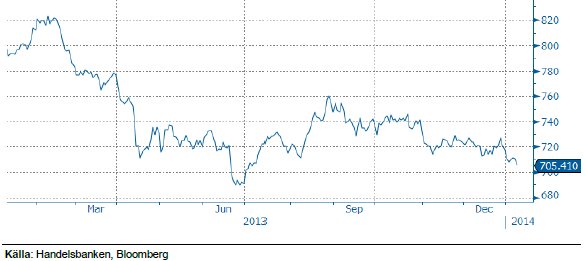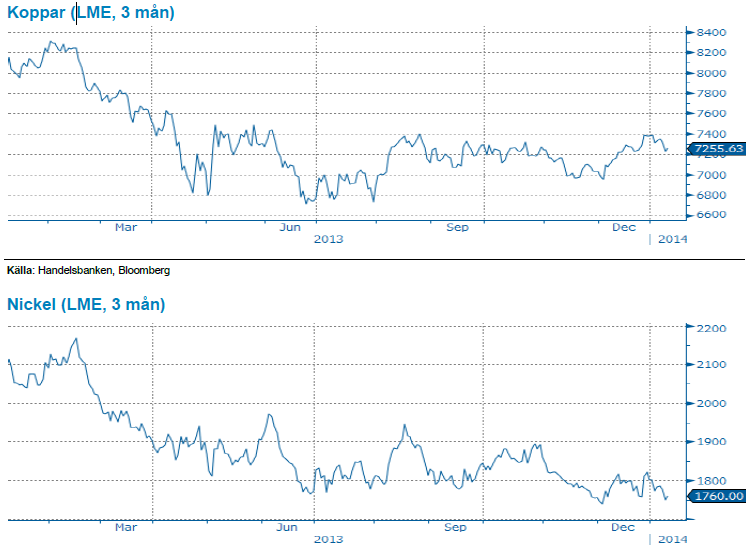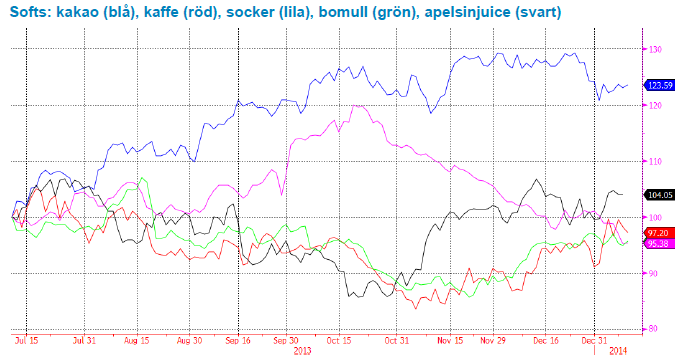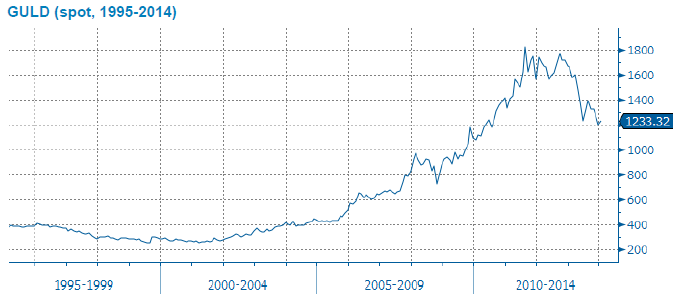Analys
SHB Råvarubrevet 10 januari 2014

Råvaror allmänt: Starkt avslut – stark början
 Fjolåret slutade med buller och bång. Stigande priser på de flesta risktillgångar trots att Feds trollspö skulle sluta vina över marknaden. Feds protokoll kom under veckan och visade att QE3 taktfast kommer dras tillbaka. Marknaden tog dock det hela med ro.
Fjolåret slutade med buller och bång. Stigande priser på de flesta risktillgångar trots att Feds trollspö skulle sluta vina över marknaden. Feds protokoll kom under veckan och visade att QE3 taktfast kommer dras tillbaka. Marknaden tog dock det hela med ro.
Detta är i mångt och mycket ”old news” nu. Mer fokus har istället hamnat på den dollarrörelse som minskad stimulans kommer orsaka. En starkare USD betyder ju fallande priser för de flesta råvaror som är noterade i dollar. Även om mycket talar för en starkare dollar just nu så vill vi understryka att det brukar se ut så i början av varje år.
Globalt fortsätter uppgången i början av det nya året. En stark impuls kommer nu till realekonomin från den positiva avslutningen på finansmarknaden under slutet av 2013. De flesta centralbanker är fokuserade på att undanröja riskerna på nedsidan och framförallt deflationsrisker vilket också är positivt för risktillgångar som råvaror.
Vårt tema med starkare basmetaller efter en lagerrörelse i Kina håller på att spela ut. Ett basmetallrally i december tror vi kan gå lite längre före nedsidan öppnar sig igen. Lagernivåerna för koppar har fallit ordentligt nu.
Amerikanska sysselsättningssiffror i form av non-farm payrolls (antal nya jobb utanför jordbrukssektorn) överraskade under fredagseftermiddag på nedsidan och kom in på 74 000 mot förväntade 197 000 nya jobb. Detta fick visserligen oljan att falla initialt men återhämtade sig strax därefter. Även metallerna höll sig i princip oförändrade efter beskedet.
Handelsbankens råvaruindex (USD)
Basmetaller: Indonesien i fokus
Basmetallerna inledde veckan ned på kinesisk statistik som skapade en förnyad oro kring tillväxten, såväl CCP som exportsiffror (USD 25.64 miljarder handelsöverskott mot förväntat 32.15) kom in under förväntan. Mot helgen är det mest fokus på nickel som stiger och där Indonesiens exportförbud av malm nu träder i kraft på måndag, detta för att stötta den inhemska industrin och lokal anrikning av metall snarare än export av låghaltig malm.
Kinas kopparimport steg 29 procent under december jämfört med förra året vilket också drar med sig övriga metaller men i övrigt får dagens uppgång kanske snarare betecknas som short-covering inför amerikanska sysselsättningssiffror. Koppar är väl annars den metall som har den svagare balansen, framför allt raffinerad koppar som kan bli riktigt tight under året, och kanske till viss del även zink. Annars är det svårt att motivera någon kraftig uppgång på metaller om man ser till det överskott vi har och kommer får leva med under året och en bit in på 2015, framför allt för aluminium och nickel. Den som går i tankar att köpa basmetaller på dessa nivåer, som ändå får betecknas som låga, bör därför ha en något längre vy. Vi noterar även att kinesisk bilförsäljning steg med 14 procent under 2014 då hela 21.98 miljoner bilar såldes i landet!
Vi ser basmetallerna som köpvärda på dessa nivåer, trots att uppsidan ser begränsad ut i dagsläget tror vi på stigande priser på längre sikt. Vi tror på: LONG BASMETALLER H
Energi: Det milda vädret har pressat ned elpriset
Elpriset befinner sig i en fallande trend sedan oktober och det milda och blöta vädret torde väl inte passerat någon obemärkt. Även på kontinenten har priserna fallit samtidigt som utsläppsrätter och kol handlas oförändrat under perioden. Den nordiska energibalansen har förbättrats rejält och spotpriset för ”vintermånaden” december blev 5.4 öre lägre än årssnittet om 38.10 öre/kWh.
På dessa låga elprisnivåer får vi räkna med kraftiga prisrörelser så fort vädret slår om vilket också visat sig under årets inledande handel där närmsta kvartalet steg med över 7 procent på prognoser som visade temperaturomslag från 5 grader över normalt till 5 grader under normalt för de kommande 10 dagarna. Senaste prognoserna visar dock att vi efter denna köldknäpp går tillbaka mot ett mer normalbetonat väder så vi håller nu en neutral vy tills sannolikheten för en högtrycksblockering ökar.
Oljan tappar 3.5 procent under årets inledande handel efter att Libyen nu återupptagit verksamheten vid ett flertal pumpar och ser ut att öka produktionen för första gången på tio månader (nu ca 500,00 fat per dag). Samtidigt har den fundamentala balansen förbättrats ytterligare efter att USA nått sin högsta produktion på över 20 år, 8.5 miljoner fat per dag, samtidigt som den inhemska efterfrågan vikit något. Det återspeglas även i veckans lagersiffror från EIA som visar att råoljeproduktionen ökar och raffinaderierna processar denna till bränslen som nu lagras. Även om detta är negativt för prisbilden påverkar det WTI-Brent spreaden ännu mer, 15.38 dollar var den som mest under veckan när rebeller sprängde en oljeledning i norra Irak. Vi tror fortsatt att det kommer ges möjligheter till god avkastning i denna range-baserade handel där oljan är köpvärd var gång den kommer ned på dessa lite lägre nivåer, lägg därtill den positiva effekten genom terminsavdraget på olja (rabatt på termin i förhållande till spot vilken ger en positiv rullningsavkastning) som ser ut att bestå.
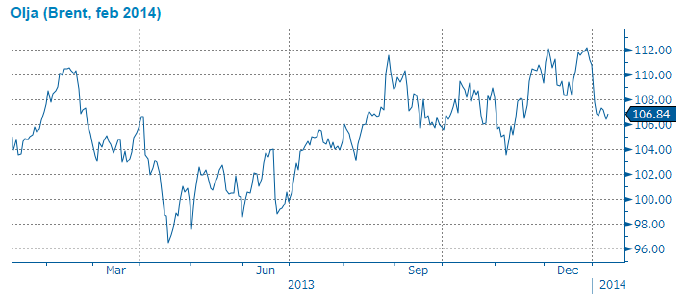 Vi tror att det kommer ges möjligheter till god avkastning i denna range-baserade handel där oljan är köpvärd var gång den kommer ned på dessa lite lägre nivåer Vi tror på: LONG OLJA H
Vi tror att det kommer ges möjligheter till god avkastning i denna range-baserade handel där oljan är köpvärd var gång den kommer ned på dessa lite lägre nivåer Vi tror på: LONG OLJA H
Livsmedel: Vetet faller och bör fortsätta nedåt
Terminspriserna på vete har under veckan backat. Den kyla som skapat viss oro i delar av USA tycks nu vara över och snart väntas återigen temperaturer över det normala. I EU är det varmt och regnigt och grödorna är fina. För tillfället ingen oro men detta kan snabbt ändras om temperaturen faller då det skyddande snötäcke är begränsat. Även i Ukraina och Ryssland finns det lite snö, även där är dock vädret väldigt milt. Det finns gott om vete att tillgå i världen och för tillfället inga större problem att tala om. Utan att temperaturen i viktiga regioner snabbt vänder nedåt med ökad risk för utvintring är det svårt att se varför trenden med fallande priser inte fortsätter.
Terminspriserna på samtliga mjuka råvaror steg under årets sista månader med undantag för socker, där vi för tillfället har ett överskott på marknaden. Kakao tillhör årets vinnare kaffe årets förlorare. Terminspriserna på kaffe har haft en fantastisk utveckling sedan i mitten av december. Vändningen kom efter flera år av fallande priser där produktionen överstigit konsumtionen. Trots ett off-år förra året har kaffeåret 2012/2013 bjudit på goda skördar. Många kaffeodlare går idag med förlust och oron kring utbudsstörningar på sikt ökar. Kommer kaffeproducenterna att bli tvungna att överge sin råvara? Andra faktorer som gett stöd till den senaste tidens terminspriser är de ökade produktionskostnaderna samt sämre kvalité på förra årets skörd som följd av sämre väderförhållanden.
Stor skörd på ingång i Brasilien för sojabönor. Vi tror på: BEAR SOJA H
Fokus: Guld
2013 – näst sämsta året någonsin för guld. Vänder det nu?
Som våra läsare vet har vi varit negativa på guld en längre tid – något som visat sig bli väldigt korrekt. Guldpriset föll under 2013 med hela 28 %, och utflödet ur börshandlade guldfonder (ETF) har varit obönhörligt, investeringar i guld-ETF:er har minskat med 33 %. Vår egen valutareserv i Riksbanken har tappat nästan 14 miljarder kronor i värde under året, och en lång rad guldgruvor och prospekteringsprojekt har fått stängas ner. Endast 1981 har varit ett sämre år i guldets historia, då med ett fall på nästan 33 %. Frågan vi alla ställer nu är naturligtvis ”kan det bli värre – eller vänder det nu?”
Vårt resonemang bakom guldet är som bekant att priset på guld bestäms av marknadsaktörernas vilja att tjäna (eller rädsla att förlora) pengar. Övriga råvaror förbrukas, och prissätts därför av efterfrågan och utbud, och därtill kopplade förväntningar och betalningsvilja. Guldet köper man helt enkelt för att någon gång i framtiden sälja dyrare till någon annan, som i sin tur vill göra om samma trick. En väldigt liten del av jordens guldreserver ”förbrukas” i form av industriell användning, och denna del återvinns.
Just dynamiken i att köpa för att sälja dyrare fungerar utmärkt så länge tillflödet av nya vinsthungriga aktörer hela tiden växer, något som eldas på av rubriker om nya prisrekord och resonemang om att ”det är annorlunda denna gången”. När trenden vänder blir man sittande, och man får hoppas att priset kommer tillbaks så man kan sälja utan att förlora pengar.
Förra gången det begav sig – 1981 – hade prisutvecklingen fram till dess att det ”toppade” påmint om den vi såg fram till slutet av 2011, dvs en väldigt kraftig uppgång, nästan utan rekyler, och orsaken var också jämförbar (allmänheten fick börja placera i guld ett par år tidigare – nu har vi kunnat placera i ETF i snart tio år). Detta gör att det känns nära till hands att jämföra nu och då, det skadar aldrig med lite historiskt perspektiv, och historien tenderar ju att upprepa sig, även om det mycket väl kan var ”annorlunda denna gång”. Då vi såg ganska många som köpte guld nära topparna under 2011 så utgår vi därifrån och jämför med de som köpte nära topparna 1980, och gör ett antal observationer.
De som köpte 1980 såg sin placering tappa med 57 % innan det vände, vilket idag skulle motsvara ett fortsatt fall ner till drygt 800 dollar per uns. De kom dock tillbaks till samma nivåer och kunde sälja av sina innehav runt 2006, drygt 25 år senare, vilket idag skulle ta oss fram till år 2036. Och detta är i absoluta tal, tar vi hänsyn till inflationen så räckte inte ens topparna 2011 till, trist nog. Vill man göra en positiv jämförelse så är det värt att nämna att året efter det värsta, dvs 1982, så steg priset med ca 15 %, innan fallet fortsatte. Så för den som inte blivit bränd redan så kan historien ge stöd för ett opportunistiskt köp.
Vi tror dock att det är att leka med elden att köpa nu, långa positioner i guld ska vara korta i tid, snabbt in och snabbt ut, inget annat. För, som Rogoff och Reinhart konstaterat i ”This time is different”, det är ju sällan ”annorlunda denna gång”.
Handelsbankens råvaruindex
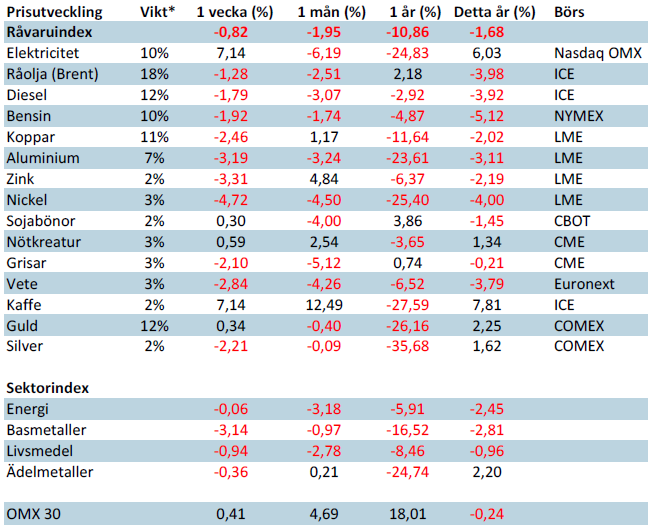
*Uppdaterade vikter från 29 november 2013. Handelsbankens råvaruindex består av de underliggande indexen för respektive råvara. Vikterna är bestämda till hälften från värdet av nordisk produktion (globala produktionen för sektorindex) och till hälften från likviditeten i terminskontrakten.
[box]SHB Råvarubrevet är producerat av Handelsbanken och publiceras i samarbete och med tillstånd på Råvarumarknaden.se[/box]
Ansvarsbegränsning
Detta material är producerat av Svenska Handelsbanken AB (publ) i fortsättningen kallad Handelsbanken. De som arbetar med innehållet är inte analytiker och materialet är inte oberoende investeringsanalys. Innehållet är uteslutande avsett för kunder i Sverige. Syftet är att ge en allmän information till Handelsbankens kunder och utgör inte ett personligt investeringsråd eller en personlig rekommendation. Informationen ska inte ensamt utgöra underlag för investeringsbeslut. Kunder bör inhämta råd från sina rådgivare och basera sina investeringsbeslut utifrån egen erfarenhet.
Informationen i materialet kan ändras och också avvika från de åsikter som uttrycks i oberoende investeringsanalyser från Handelsbanken. Informationen grundar sig på allmänt tillgänglig information och är hämtad från källor som bedöms som tillförlitliga, men riktigheten kan inte garanteras och informationen kan vara ofullständig eller nedkortad. Ingen del av förslaget får reproduceras eller distribueras till någon annan person utan att Handelsbanken dessförinnan lämnat sitt skriftliga medgivande. Handelsbanken ansvarar inte för att materialet används på ett sätt som strider mot förbudet mot vidarebefordran eller offentliggörs i strid med bankens regler.
Analys
Tightening fundamentals – bullish inventories from DOE

The latest weekly report from the US DOE showed a substantial drawdown across key petroleum categories, adding more upside potential to the fundamental picture.

Commercial crude inventories (excl. SPR) fell by 5.8 million barrels, bringing total inventories down to 415.1 million barrels. Now sitting 11% below the five-year seasonal norm and placed in the lowest 2015-2022 range (see picture below).
Product inventories also tightened further last week. Gasoline inventories declined by 2.1 million barrels, with reductions seen in both finished gasoline and blending components. Current gasoline levels are about 3% below the five-year average for this time of year.
Among products, the most notable move came in diesel, where inventories dropped by almost 4.1 million barrels, deepening the deficit to around 20% below seasonal norms – continuing to underscore the persistent supply tightness in diesel markets.
The only area of inventory growth was in propane/propylene, which posted a significant 5.1-million-barrel build and now stands 9% above the five-year average.
Total commercial petroleum inventories (crude plus refined products) declined by 4.2 million barrels on the week, reinforcing the overall tightening of US crude and products.


Analys
Bombs to ”ceasefire” in hours – Brent below $70

A classic case of “buy the rumor, sell the news” played out in oil markets, as Brent crude has dropped sharply – down nearly USD 10 per barrel since yesterday evening – following Iran’s retaliatory strike on a U.S. air base in Qatar. The immediate reaction was: “That was it?” The strike followed a carefully calibrated, non-escalatory playbook, avoiding direct threats to energy infrastructure or disruption of shipping through the Strait of Hormuz – thus calming worst-case fears.

After Monday morning’s sharp spike to USD 81.4 per barrel, triggered by the U.S. bombing of Iranian nuclear facilities, oil prices drifted sideways in anticipation of a potential Iranian response. That response came with advance warning and caused limited physical damage. Early this morning, both the U.S. President and Iranian state media announced a ceasefire, effectively placing a lid on the immediate conflict risk – at least for now.
As a result, Brent crude has now fallen by a total of USD 12 from Monday’s peak, currently trading around USD 69 per barrel.
Looking beyond geopolitics, the market will now shift its focus to the upcoming OPEC+ meeting in early July. Saudi Arabia’s decision to increase output earlier this year – despite falling prices – has drawn renewed attention considering recent developments. Some suggest this was a response to U.S. pressure to offset potential Iranian supply losses.
However, consensus is that the move was driven more by internal OPEC+ dynamics. After years of curbing production to support prices, Riyadh had grown frustrated with quota-busting by several members (notably Kazakhstan). With Saudi Arabia cutting up to 2 million barrels per day – roughly 2% of global supply – returns were diminishing, and the risk of losing market share was rising. The production increase is widely seen as an effort to reassert leadership and restore discipline within the group.
That said, the FT recently stated that, the Saudis remain wary of past missteps. In 2018, Riyadh ramped up output at Trump’s request ahead of Iran sanctions, only to see prices collapse when the U.S. granted broad waivers – triggering oversupply. Officials have reportedly made it clear they don’t intend to repeat that mistake.
The recent visit by President Trump to Saudi Arabia, which included agreements on AI, defense, and nuclear cooperation, suggests a broader strategic alignment. This has fueled speculation about a quiet “pump-for-politics” deal behind recent production moves.
Looking ahead, oil prices have now retraced the entire rally sparked by the June 13 Israel–Iran escalation. This retreat provides more political and policy space for both the U.S. and Saudi Arabia. Specifically, it makes it easier for Riyadh to scale back its three recent production hikes of 411,000 barrels each, potentially returning to more moderate increases of 137,000 barrels for August and September.
In short: with no major loss of Iranian supply to the market, OPEC+ – led by Saudi Arabia – no longer needs to compensate for a disruption that hasn’t materialized, especially not to please the U.S. at the cost of its own market strategy. As the Saudis themselves have signaled, they are unlikely to repeat previous mistakes.
Conclusion: With Brent now in the high USD 60s, buying oil looks fundamentally justified. The geopolitical premium has deflated, but tensions between Israel and Iran remain unresolved – and the risk of missteps and renewed escalation still lingers. In fact, even this morning, reports have emerged of renewed missile fire despite the declared “truce.” The path forward may be calmer – but it is far from stable.
Analys
A muted price reaction. Market looks relaxed, but it is still on edge waiting for what Iran will do

Brent crossed the 80-line this morning but quickly fell back assigning limited probability for Iran choosing to close the Strait of Hormuz. Brent traded in a range of USD 70.56 – 79.04/b last week as the market fluctuated between ”Iran wants a deal” and ”US is about to attack Iran”. At the end of the week though, Donald Trump managed to convince markets (and probably also Iran) that he would make a decision within two weeks. I.e. no imminent attack. Previously when when he has talked about ”making a decision within two weeks” he has often ended up doing nothing in the end. The oil market relaxed as a result and the week ended at USD 77.01/b which is just USD 6/b above the year to date average of USD 71/b.

Brent jumped to USD 81.4/b this morning, the highest since mid-January, but then quickly fell back to a current price of USD 78.2/b which is only up 1.5% versus the close on Friday. As such the market is pricing a fairly low probability that Iran will actually close the Strait of Hormuz. Probably because it will hurt Iranian oil exports as well as the global oil market.
It was however all smoke and mirrors. Deception. The US attacked Iran on Saturday. The attack involved 125 warplanes, submarines and surface warships and 14 bunker buster bombs were dropped on Iranian nuclear sites including Fordow, Natanz and Isfahan. In response the Iranian Parliament voted in support of closing the Strait of Hormuz where some 17 mb of crude and products is transported to the global market every day plus significant volumes of LNG. This is however merely an advise to the Supreme leader Ayatollah Ali Khamenei and the Supreme National Security Council which sits with the final and actual decision.
No supply of oil is lost yet. It is about the risk of Iran closing the Strait of Hormuz or not. So far not a single drop of oil supply has been lost to the global market. The price at the moment is all about the assessed risk of loss of supply. Will Iran choose to choke of the Strait of Hormuz or not? That is the big question. It would be painful for US consumers, for Donald Trump’s voter base, for the global economy but also for Iran and its population which relies on oil exports and income from selling oil out of that Strait as well. As such it is not a no-brainer choice for Iran to close the Strait for oil exports. And looking at the il price this morning it is clear that the oil market doesn’t assign a very high probability of it happening. It is however probably well within the capability of Iran to close the Strait off with rockets, mines, air-drones and possibly sea-drones. Just look at how Ukraine has been able to control and damage the Russian Black Sea fleet.
What to do about the highly enriched uranium which has gone missing? While the US and Israel can celebrate their destruction of Iranian nuclear facilities they are also scratching their heads over what to do with the lost Iranian nuclear material. Iran had 408 kg of highly enriched uranium (IAEA). Almost weapons grade. Enough for some 10 nuclear warheads. It seems to have been transported out of Fordow before the attack this weekend.
The market is still on edge. USD 80-something/b seems sensible while we wait. The oil market reaction to this weekend’s events is very muted so far. The market is still on edge awaiting what Iran will do. Because Iran will do something. But what and when? An oil price of 80-something seems like a sensible level until something do happen.
-

 Nyheter4 veckor sedan
Nyheter4 veckor sedanUppgången i oljepriset planade ut under helgen
-

 Nyheter3 veckor sedan
Nyheter3 veckor sedanMahvie Minerals växlar spår – satsar fullt ut på guld
-

 Nyheter4 veckor sedan
Nyheter4 veckor sedanLåga elpriser i sommar – men mellersta Sverige får en ökning
-

 Nyheter2 veckor sedan
Nyheter2 veckor sedanOljan, guldet och marknadens oroande tystnad
-

 Nyheter2 veckor sedan
Nyheter2 veckor sedanJonas Lindvall är tillbaka med ett nytt oljebolag, Perthro, som ska börsnoteras
-

 Analys4 veckor sedan
Analys4 veckor sedanVery relaxed at USD 75/b. Risk barometer will likely fluctuate to higher levels with Brent into the 80ies or higher coming 2-3 weeks
-

 Analys3 veckor sedan
Analys3 veckor sedanA muted price reaction. Market looks relaxed, but it is still on edge waiting for what Iran will do
-

 Nyheter2 veckor sedan
Nyheter2 veckor sedanDomstolen ger klartecken till Lappland Guldprospektering


